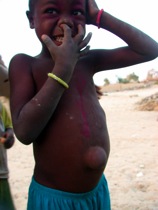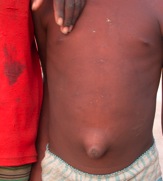Origins of Timbuktu
The variations in the legends
of the origins of Timbuktu are myriad. Judging by the
earliest mentions of the town in literature it was founded
around the beginning of the eleventh century. That is, in
the first decade of the 1000's, so, while the exact date is
unknown, it can be assumed to be almost exactly a thousand
years ago.
Each local language has a slightly different pronunciation
of Timbuktu and historical documents such as writings of
the first explorers and old maps of Africa show varied
spellings. Tombut is on a ---century French map, for
example, and in the beginning of the 16th century Leo
Africanus writes Tombutto. D. Pacheco Perieira in 1506-1508
wrote Tabucutu. Rene Caillie wrote Tem boctou; others
Timboutch. Today many European countries also have their
own version of the name: Timbuktu, Timbuctoo, Tombouctou to
name a few. These variations lead to different hypotheses
on where the word came from.
Each ethnic group in the area lays claim to the founding of
Timbuktu, either with a new myth or a twisting of the most
common ones. Most of these agree on the point that Tim (or
Tom in French) is a mispronunciation of tin. While tim means
nothing tin
is the feminine
of in, which means a possession,
property of. In this case, possession of land or, literally
property. At that time, and even today in the desert,
whosoever controls the water source controls the land in a
given radius around it, this radius being determined by the
distance the animals can go in search of grazing before
they must return for water. Thus possession of a well and
possession of property become synonymous. Looking on a map
of Mali one can see many places are named
Tin-something and many more that
are In-something.
The most common myth tells of a woman, Buktu, who settled
near the banks of the Niger. Her well became the centre of
a camp and stopping place for caravans and finally a
village after which Buktu’s tin, Timbuktu, became a major
commercial centre. Details vary. According to certain
versions Buktu was an old slave woman who chose to stay (or
was chosen to stay) at this site instead of moving with the
rest of the nomads. She remained near the water point to
tend the animals in her charge and maintain the water
source for the tribe who returned to the area nearer the
river during the drier seasons.


Others argue that the term butu is not confined to a navel but can be a depression of any sort and is a reference to a low spot between the dunes. In this case there is not necessarily any person involved simply a well at a low spot.
Others put forth the tamacheq terms imbakewen, object, and timbakewen, "those who guard objects," as the origin of the name.
Perhaps Buktu with a big butu had some property where she gaurded a well between the dunes....
In fact the name buktu shows up rather late in literature with the earliest mentions being with a t rather than a k and many local people when talking of the town in their native languages pronounce it timbutu it gives more credence to those than the woman name Buktu, a name which is otherwise unknown in the area characterized by reusing the same names.
As seen above the Tuareg and the Sognai have each a couple arguments to stake their claim to the founding of Timbuktu. The Bella (black Tuareg, decendents of the slaves of the Tamacheq) have also put forth a legend less known and less probable. In fact it seems to be an attempt to vindicate their status as slaves.
In this version a Songai woman named Gaichatou Tin-Atouboutoute (which means woman of the great navel in Tamacheq) came from away and stopped in the area (where there were seasonal lakes at the time) to recover from injuries sustained when a thorn tree fell on her. She decided to settle there and her brother when he came looking for her could not convince her to return home so when their parents died he and his wife moved to this new location. Later Tuareg merchants came to the area and became so numerous that these few Songai lost their language. Slaves from the Tuareg and Songai empires were settled in the same area and lived in grass huts like them. When much later all the grass huts were burned and the slaves were settled in one neighbourhood these descendants of the original settlers were mixed in, mistaken for Bella themselves. These same people claim to have discovered the wild watermelon and taken to cultivating it. A couple things make this story improbable. One is that she was supposed to come from east of Rarouse - a long way to come on foot, especially if wounded. Also if she was Songai why is her name Tamacheq; even if language was lost the name wouldn't be.
The site of Buktu's well is ostensibly in the courtyard of the municipal museum. In fact, according to one local historian the original site of Timbuktu was not at its present location but some 7 km north-northeast and had changed sites more than once before settling at the current location. At the time of its founding the Niger had more water and flooded its banks regularly flooding a couple of wadis and many seasonal ponds on and around the site of present day Timbuktu. As water levels lowered and flooding was not so widespread Timbuktu moved to stay close to the tributary that would allow trade on the Niger. Today we see that the river has receded still farther and the tributary as well as the channel the Moroccans dug have dried up.
In any case whether it was the property of Buktu or some other, no matter the size of her belly button, the simple camp evolved to a village and then to a major centre of trade. Whether it was actually first settled by Songai or Tuareg, it first came into importance under Tuareg control. Being strategically located between the north and south, river and desert, it quickly became the staging point for caravans bringing salt and goods from the near, middle and far east, and for boats bringing goods from the south or “black Africa,” known collectively at the time as Sudan. Gold, slaves and agricultural products were brought up the river and tea, sugar, spices, and books went down. Its fabulous wealth and unattainable location (for Europeans) in the middle of the Sahara surrounded by proud blue men, fierce warriors, helped to give Timbuktu its legends and mystery which remain compelling to this day.
The strategic location that gave Timbuktu its economic importance also led to every successive empire in the area seizing control of it, giving the town a something of a bloody history as well.